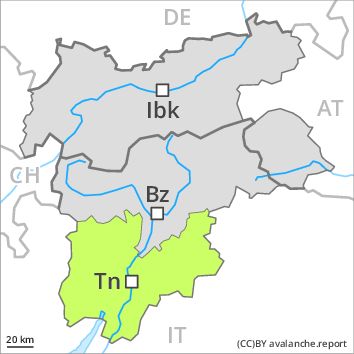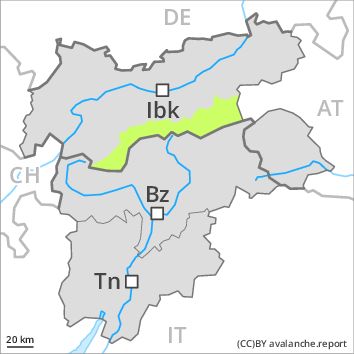Regions
Latemar, Southern Adamello, Primiero - Pale di S. Martino, Adamello - Presanella, Prealps, Northern Brenta - Peller, Cembra Valley, Bondone and Stivo, Vallarsa, Folgaria - Laverone, Western Nonsberg Alps, Southern Brenta, Fassa Valley, Southern Lagorai, Sole, Pejo and Rabbi, Northern Lagorai, Ledro Valley, Maddalene, Paganella, Pine' - Mocheni Valley, Marzola - Valsugana

Danger level
Danger Level 1 - Low
Avalanche Problem
Gliding snow above 2400m, E-SE-S-SW-W

A favourable avalanche situation will prevail.
Low, level 1. The avalanche prone locations are very rare and are clearly recognisable to the trained eye.
A latent danger of gliding avalanches exists, in particular on steep sunny slopes below approximately 2400 m as well as on steep shady slopes below approximately 2000 m. Areas with glide cracks are to be avoided as far as possible.
Dry avalanches can in very isolated cases be released in the old snowpack by large loads. Caution is to be exercised in particular on extremely steep shady slopes, especially adjacent to ridgelines and in areas where the snow cover is rather shallow. Here individual mostly small avalanches are possible. Restraint should be exercised because avalanches can sweep people along and give rise to falls.
Snowpack
dp 2: gliding snow
dp 7: snow-poor zones in snow-rich surrounding
In some places relatively hard layers of snow are lying on old snow containing large grains, in particular on shady slopes at high altitudes and in high Alpine regions as well as adjacent to ridgelines.
The old snowpack will be moist at low and intermediate altitudes. The surface of the snowpack will soften later than the day before. This applies on sunny slopes.
Tendency
The backcountry touring conditions remain favourable.
Regions
Gurgler Range, Central Stubai Alps, Northern Zillertal Alps

Danger level
Danger Level 1 - Low
Avalanche Problem
Wind-drifted snow above 2000m, N-NE-NW

A favourable avalanche situation will prevail. Fresh wind slabs require caution. This applies in the regions exposed to the foehn wind.
Low, level 1. The avalanche prone locations are very rare and are clearly recognisable to the trained eye.
A latent danger of gliding avalanches exists, in particular on steep sunny slopes below approximately 2400 m as well as on steep shady slopes below approximately 2000 m. Areas with glide cracks are to be avoided as far as possible.
Dry avalanches can in very isolated cases be released in the old snowpack by large loads. Caution is to be exercised in particular on extremely steep shady slopes, especially adjacent to ridgelines and in areas where the snow cover is rather shallow. Here individual mostly small avalanches are possible. Restraint should be exercised because avalanches can sweep people along and give rise to falls.
As a consequence of a moderate to strong southwesterly wind, mostly small wind slabs will form in particular adjacent to ridgelines. This applies in the regions exposed to the foehn wind.
Snowpack
dp 2: gliding snow
dp 7: snow-poor zones in snow-rich surrounding
In some places relatively hard layers of snow are lying on old snow containing large grains, in particular on shady slopes at high altitudes and in high Alpine regions as well as adjacent to ridgelines.
The old snowpack will be moist at low and intermediate altitudes. The surface of the snowpack will soften during the day. This applies on sunny slopes.
Tendency
The backcountry touring conditions remain favourable.
Regions
Sexten Dolomites, Val Müstair Alps, Western Verwall Mountains, Langtaufers, Eastern Verwall Mountains, Schnals Ridge, Silvretta, Southern Stubai Alps, Samnaun Mountains, Southern Zillertal Alps and High Tauern, Northern Oetz and Stubai Alps, Saldurn-Mastaun Ridge, Western Tuxer Alps, Texel Mountains, Eastern Tuxer Alps, Sarntal Alps, Western Kitzbühel Alps, Western Pfunderer Mountains, Eastern Kitzbühel Alps, Glockturm Range, Eastern Pfunderer Mountains, Durreck Range, Weißkugel Range, Western Rieserferner Mountains, Western Deferegger Alps, Ortler Range, Allgäu Alps, Ulten Valley, Eastern Lechtal Alps - Ammergau Alps, Venediger Range, Eastern Nonsberger Alps, Mieming Mountains, Eastern Rieserferner Mountains, Northern Dolomites of Fiemme, Karwendel Mountains, Glockner Range, Gröden Dolomites, Brandenberg Alps, Eastern Deferegger Alps, Prags Dolomites, Wilder Kaiser Mountains - Waidring Alps, Schober Mountains, Western Lechtal Alps, Lienzer Dolomites, Central Lechtal Alps, Grieskogel Mountains

Danger level
Danger Level 1 - Low
Avalanche Problem
Favourable situation above 2400m

A favourable avalanche situation will prevail.
Low, level 1. The avalanche prone locations are very rare and are clearly recognisable to the trained eye.
A latent danger of gliding avalanches exists, in particular on steep sunny slopes below approximately 2400 m as well as on steep shady slopes below approximately 2000 m. Areas with glide cracks are to be avoided as far as possible.
Dry avalanches can in very isolated cases be released in the old snowpack by large loads. Caution is to be exercised in particular on extremely steep shady slopes, especially adjacent to ridgelines and in areas where the snow cover is rather shallow. Here individual mostly small avalanches are possible. Restraint should be exercised because avalanches can sweep people along and give rise to falls.
Snowpack
dp 2: gliding snow
dp 7: snow-poor zones in snow-rich surrounding
In some places relatively hard layers of snow are lying on old snow containing large grains, in particular on shady slopes at high altitudes and in high Alpine regions as well as adjacent to ridgelines.
The old snowpack will be moist at low and intermediate altitudes. The surface of the snowpack will soften during the day. This applies on sunny slopes.
Tendency
The backcountry touring conditions remain favourable.



